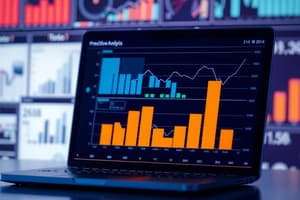Podcast
Questions and Answers
What key characteristic differentiates data analytics from everyday decision-making?
What key characteristic differentiates data analytics from everyday decision-making?
- Data analytics involves testing hypotheses. (correct)
- Data analytics is limited to business contexts.
- Everyday decision-making relies on emotional responses.
- Everyday decisions do not require data.
Which step in data analysis focuses on defining the problem and desired outcome?
Which step in data analysis focuses on defining the problem and desired outcome?
- Understanding the Problem (correct)
- Cleaning Data
- Gathering Data
- Setting a Clear Metric
What is the purpose of prescriptive analytics in the field of data analytics?
What is the purpose of prescriptive analytics in the field of data analytics?
- To predict future trends.
- To determine what should be done. (correct)
- To summarize historical data.
- To automate data gathering.
Which of the following most accurately describes 'storytelling with data'?
Which of the following most accurately describes 'storytelling with data'?
Which step involves examining cleaned data to identify patterns and trends?
Which step involves examining cleaned data to identify patterns and trends?
What is a critical factor to ensure accuracy during data analysis?
What is a critical factor to ensure accuracy during data analysis?
In which way can data analytics aid communication in decision-making?
In which way can data analytics aid communication in decision-making?
What does setting a clear metric entail in the data analysis process?
What does setting a clear metric entail in the data analysis process?
What is the primary purpose of prescriptive analytics?
What is the primary purpose of prescriptive analytics?
Which of the following best distinguishes data analytics from data analysis?
Which of the following best distinguishes data analytics from data analysis?
In the data analysis process, why is it essential to set clear metrics for evaluation?
In the data analysis process, why is it essential to set clear metrics for evaluation?
Which role primarily focuses on deriving insights from complex datasets to influence business strategy?
Which role primarily focuses on deriving insights from complex datasets to influence business strategy?
How does machine learning impact modern data ecosystems?
How does machine learning impact modern data ecosystems?
What is a key outcome of communicating findings effectively in analytics?
What is a key outcome of communicating findings effectively in analytics?
What is the primary purpose of data analytics for a CPA?
What is the primary purpose of data analytics for a CPA?
Which of the following steps is not part of the data analytics process?
Which of the following steps is not part of the data analytics process?
What differentiates data analytics from data analysis?
What differentiates data analytics from data analysis?
In data analytics, what is typically the last step after analysis is performed?
In data analytics, what is typically the last step after analysis is performed?
What is the primary focus of targeted decision-making in data analytics?
What is the primary focus of targeted decision-making in data analytics?
How is data analysis typically applied, based on the content?
How is data analysis typically applied, based on the content?
What is a common misconception about data analysis?
What is a common misconception about data analysis?
What aspect of communication is crucial in data analytics?
What aspect of communication is crucial in data analytics?
Flashcards are hidden until you start studying
Study Notes
Data Analytics Overview
- Data Analytics involves collecting and analyzing information to tell a story and convey insights clearly to various stakeholders.
- It supports everyday decision-making on a larger scale, enabling complex choices based on data.
- The process includes identifying a problem, forming a hypothesis, and testing it through data collection, cleaning, analysis, and presentation.
Key Analytics Types
- Descriptive Analytics: Answers "What happened?"
- Diagnostic Analytics: Explains "Why it happened?"
- Predictive Analytics: Forecasts "What will happen next?"
- Prescriptive Analytics: Suggests "What should be done next?"
Key Steps in Data Analysis
- Understanding the Problem: Begin with a clear definition of the problem and desired outcomes.
- Setting a Clear Metric: Establish measurable criteria (e.g., regional sales over a specific period).
- Gathering Data: Identify necessary data sources and tools for analysis.
- Cleaning Data: Resolve quality issues such as missing values and outliers for accuracy.
- Analyzing and Mining Data: Explore cleaned data for patterns, trends, and correlations.
- Interpreting Results: Evaluate findings while considering limitations and objections.
- Presenting Findings: Communicate analyses effectively through reports, dashboards, and charts to support decision-making.
Perspectives on Data Analytics
- Data analytics encompasses storytelling, whereby data is used to test hypotheses and clarify status efficiently.
- It is fundamentally about problem-solving, where outcomes are supported by data-driven insights.
- For financial professionals, it provides insights into a company’s financial status, informing predictions and strategic decisions.
- It enhances communication and decision-making by sharing analyses that clarify business or data situations.
Modern Data Ecosystem
- Consists of a complex network of interconnected elements, featuring diverse data formats and sources.
- Involves an enterprise data environment for organizing and cleaning data.
- Key roles include Data Engineers, Data Analysts, Data Scientists, Business Analysts, and Business Intelligence Analysts, all working towards deriving actionable insights.
Difference Between Data Analytics and Data Analysis
- Data Analysis: Focuses on detailed examination to understand past performance, often irrespective of numbers.
- Data Analytics: Involves systematic computational analysis of data for deriving insights and making predictions, primarily focusing on numerical manipulation.
- The terms are used interchangeably within this course context, despite subtle differences in broader usage.
Studying That Suits You
Use AI to generate personalized quizzes and flashcards to suit your learning preferences.




